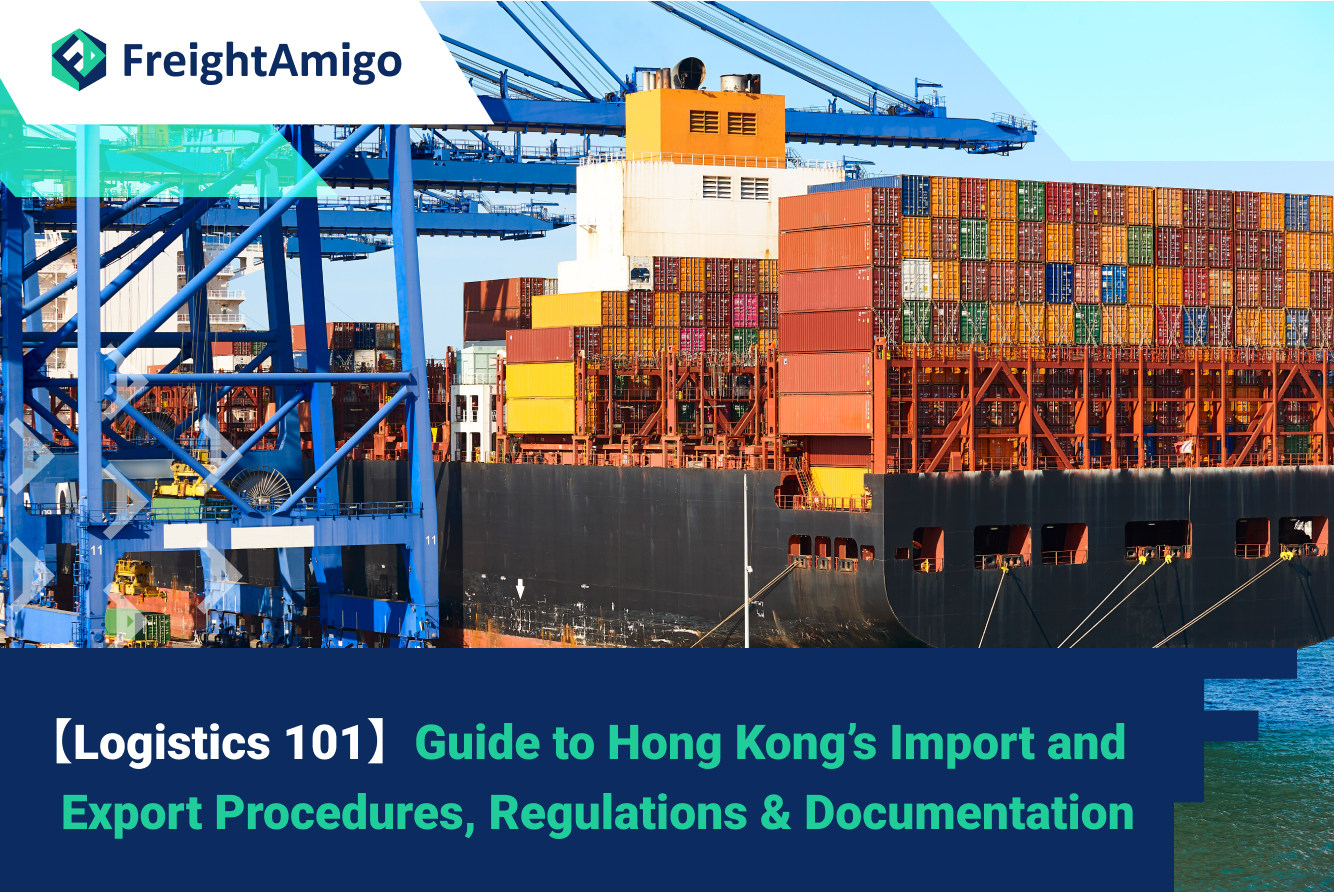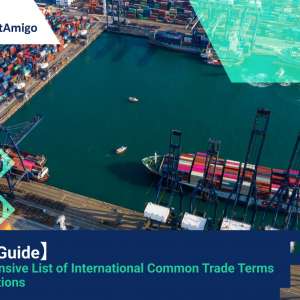Author Name:Tiffany Lee – Marketing Analyst at FreightAmigo
Hong Kong is one of the important participants in the global trading market and a significant trading hub in the Asia region. Hong Kong‘s exported goods include electronic products, clothing, and machinery equipment, while its imported goods mainly consist of raw materials and other products to support the manufacturing and service industries. Hong Kong’s economic system and legal system are independent of the mainland China, making it an ideal choice for businesses to expand into the Asian market. To promote the free flow of trade, Hong Kong has formulated a series of policies and regulations, including import and export licensing requirements, customs procedures, and trade agreements with other countries.
In this context, understanding the import and export procedures, regulations, and document strategies in Hong Kong is essential for businesses engaged in international trade. FreightAmigo has created a one-stop guide to help you familiarize yourself with the necessary information, and both buyers and sellers can benefit from it.
Want to compare the best Express, Air Freight, Sea Freight, Rail Freight & Trucking rates so as to have better control on cost?
Import Procedures in Hong Kong
1. Establish Market Objectives | - Set pricing and trade term objectives for overseas market situations |
2. Procure Products | - Source suppliers |
3. Familiar with Trade Regulations | - Determine import regulations and requirements and whether an import permit is necessary |
4. Identify channels | - Inquire with suitable suppliers |
5. Finalize the Quotation and Trading Terms | - Analyze supplier quotations |
6. Arrange Funding for Transactions | - Arrange for working capital and prepare for it |
7. Sales Contract | - Determine sales contracts and trading terms, such as payment methods |
8. Arrange Payment and Insurance | - Arrange payment and insurance according to the sales contract provisions (for example, if the contract specifies payment by documentary credit, it is necessary to apply to the issuing bank for a documentary credit; if the trade term is FOB, temporary insurance must be arranged with the insurance company) |
9. Pick Up Goods | - Receive shipment and arrival notifications |
10. Customs Clearance | - Arrange for customs clearance procedures and import declaration |
Export Procedures in Hong Kong
1. Market Research and Objective Setting | - Select target markets, export methods, and distribution channels |
2. Trade Regulations | - Export regulations and requirements |
3. Identify Channels | - Inquire with overseas buyers |
4. Quotation and Trading Terms | - Submit quotations to prospective buyers |
5. Sales Contract | - Confirm sales contracts and trading terms, such as payment methods |
6. Contract Execution | - Produce or procure goods |
7. Customs Clearance | - Prepare export declaration forms and determine if an export license is required |
8. Payment Collection | - In accordance with the payment method specified in the sales contract, the exporter presents the necessary documents to the relevant parties and requests payment. |
Related Trade Documents for Import and Export in Hong Kong
International trade involves various types of documents, including commercial documents, financial documents, transport documents, insurance documents, and other documents related to international trade. When dealing with the transportation of exported goods, companies may need to sign up to four types of contracts: export sales contracts, transport contracts, financial contracts, and cargo insurance contracts. Therefore, companies need to understand the functions and purposes of various documents in international trade.
Commercial Documents
Quotation (prepared by the exporter) | This document provides the buyer with a detailed quotation for the goods or services being offered, including the price, quality details, quantity, trade terms, delivery conditions, and payment methods. |
Sales Contract (prepared by both the exporter and importer) | This is a legally binding contract between the buyer and seller, which specifies the terms and conditions of the transaction. It is important to seek legal advice before signing a sales contract. |
Proforma Invoice (prepared by the exporter) | This is a preliminary invoice that provides the buyer with information about the products being shipped, including the type, quantity, value, and import specifications, but is not used to request payment. It may be used for purposes such as applying for an import license, arranging foreign exchange, or other financial arrangements. |
Commercial Invoice (prepared by the exporter) | This is an official document that requests payment from the buyer according to the terms of the sales contract. It should provide detailed information about the products sold, payment methods, and trade terms. It is also used for customs clearance purposes and sometimes for arranging foreign exchange. |
Packing List (prepared by the exporter) | This document provides detailed information about the packaging of the goods being shipped. |
Inspection Certificate (prepared by an independent inspection company or the exporter) | This report certifies that the products being shipped meet thespecifications requested by the buyer or the relevant country, including quality, quantity, and/or price. |
Insurance Policy (prepared by the insurance company/agent/broker) | This document certifies that the goods being shipped have been insured and provides information about the insurance coverage. |
Insurance Certificate (prepared by the insurance company/agent/broker) | This document certifies that the goods being shipped are covered by a specific insurance policy, protecting the goods from loss or damage during shipment. |
Product Testing Certificate (prepared by an accredited laboratory) | This certificate verifies that the product meets international or specific national technical standards in terms of quality, safety, and specifications. |
Health Certificate (prepared by the exporter/inspection agency) | This document is required when exporting agricultural products or food, and certifies that the products comply with the relevant laws and regulations of the importing country, and are safe for human consumption. |
Phytosanitary Certificate (prepared by the exporter) | This certificate is required by international regulations for the import of plants or plant material, and certifies that the products being shipped are free from pests and diseases, and comply with the current phytosanitary regulations of the importing country. In Hong Kong, the certificate can be obtained from the Agriculture, Fisheries and Conservation Department. |
Fumigation Certificate (prepared by the exporter/inspection company) | This certificate is proof of pest control and certifies that the products have been treated with fumigants by an approved fumigation service provider before shipment. Customs in the United States, Canada, and the United Kingdom require wood packaging materials from Hong Kong and mainland China to be accompanied by a fumigation certificate. |
Carnet (prepared by the exporter) | This is an international customs document used to facilitate the temporary importation of goods, such as trade show exhibits, samples, and professional equipment, into countries that are signatories to the Carnet Convention. |
Consular Invoice (prepared by the exporter) | Some countries require this document, which provides detailed information about the products being shipped, such as the shipper, consignee, and value. This document is signed by consular officials in a foreign country and serves as proof of the value, quantity, and nature of the goods being shipped for customs clearance purposes. |
Transport Documents
Delivery Note (handled by the shipper/transportation company) | This document provides details about the shipment and the shipper's requirements. It is a basic document required for preparing other transportation documents. |
Dock Receipt/Mate's Receipt(handled by the shipping company) | This is a receipt that confirms the receipt of goods by the port/warehouse. It is required for preparing a bill of lading, but it is not a legally required document for payment processing. |
Bill of Lading(handled by the shipping company) | This is a contract between the owner of the goods and the carrier. Customers typically require the original bill of lading to prove ownership of the goods and to have the right to take possession of them. There are two types of bills of lading: non-negotiable straight bills of lading and negotiable or order bills of lading, which can be bought, sold, or traded during the transit of goods and used for various financing transactions. |
Carrier's Bill of Lading (handled by the freight forwarding agency) | This is a bill of lading issued by a freight forwarder or shipping agent. It is often not an ownership document. If the shipper chooses to use a carrier's bill of lading, they should clarify with the bank whether it is acceptable for credit purposes beforeusing it. Compared to individual shipping, the advantages of a carrier's bill of lading include less packaging, lower insurance premiums, faster transit times, lower risk of loss, and lower costs. |
Ocean Bill of Lading(handled by the shipping company) | This is a receipt for goods transported by sea, containing the transport contract between the shipper and the carrier. It is a non-negotiable document and not an ownership document. |
Air Waybill(handled by the shipping company) | This is a transport document used for air freight. It describes the conditions of transport and serves as a receipt for the goods, but it is not an ownership document or transferable document. |
Carrier's Air Waybill (handled by the freight forwarding agency) | This is an air waybill issued by a freight forwarder or shipping agent, providing details about the goods and recording them, but it is not an ownership document. |
Cargo Insurance(handled by the importer's bank/shipping company/consignee) | This is a form prepared in advance by the shipping company, which guarantees the return of the original transportation documents to the carrier by the importer's bank. Customers can use this document to pick up the goods without presenting the original bill of lading. This document is often used in conjunction with a trust receipt to protect the bank's control over the goods. |
Packing List(handled by the shipper) | This is a document that lists the information required for transportation, such as invoice, buyer, consignee, country of origin, flight date, loading port/airport, unloading port/airport, delivery location, shipping marks/container number, weight/volume of goods, and all other relevant details about the goods, including packing information. This document is prepared by the shipper. |
Financial Documents
Letter of Credit (issued by the opening bank upon request of the importer) | This is a bank document opened upon the request of the buyer, which certifies that the opening bank guarantees to pay a certain amount of money as long as the specific requirements listed in the letter of credit are met. |
Standby Letter of Credit (issued by the exporter/exporter's bank) | This is an arrangement made between the customer and its bank, which allows the customer to have the convenience of cashing a check for a certain amount at that bank. Or an arrangement made between the exporter and importer, which promises that if the contract cannot be completed, the exporter is required to compensate the importer for part of the losses. This is also called a performance bond. It is usually used in large-volume transactions such as crude oil, fertilizers, fish fry, sugar, urea, etc. |
Collection Instructions (issued by the exporter) | This is the instruction issued by the exporter to its bank, authorizing the bank to collect payment on behalf of the exporter according to the terms of the contract. |
Bill of Exchange (issued by the exporter) | This is an unconditional written instruction. In the instruction, the exporter requires the importer to pay a certain amount of money to the payee or holder immediately or on a future date. |
Trust Receipt (issued by the importer) | The bank issues this document to the buyer for the release of the goods (the goods remain the property of the bank). After the buyer obtains the goods, itmust keep the goods separate from its other assets and be prepared to return them to the bank at any time. |
Promissory Note (issued by the importer) | This is a transferable financial document, which certifies that the overseas buyer must pay a certain amount of money to the holder. |
Government documents
Certificate of Origin (issued by the Trade and Industry Department and five trade organizations*) | This is a certificate that proves the place of manufacture, nature/quantity/value of the goods. |
Certificate of Origin Form A under the Generalized System of Preferences (GSP) (issued by the Trade and Industry Department and five trade organizations*) | This document certifies that the exported goods of the exporting country are eligible for import tax preferences (reduction or exemption) under the GSP of the supplying country. Generally, the goods must meet the origin rules of the beneficiary country and the origin standards of the GSP of the supplying country to be eligible for Form A. Hong Kong is currently a beneficiary of the GSP of Canada and Norway. China, on the other hand, is a beneficiary of the GSP of Australia, the European Union, Canada, the Czech Republic, Poland, Russia, Slovakia, and other countries. |
Import/Export Declaration (issued by the exporter/importer) | This is a declaration form submitted to the Customs Chief when goods enter or leave the port. It is used to declare details of the goods, including the nature of the shipped goods, the destination country, the exporting country, etc. Its main function is to compile trade statistics. |
Import/Export License (issued by the Trade and Industry Department, Hong Kong Customs, Fisheries and Conservation Department, etc.) | This is a document issued by the relevant government departments authorizing the import and export of certain controlled goods. |
International Import Certificate (issued bythe Trade and Industry Department) | This is a statement issued by the destination government, certifying that the imported strategic items will be sold in the designated country. Hong Kong only issues international import certificates to meet the requirements of the exporting country. |
Certificate of Arrival of Goods (issued by the Trade and Industry Department) | This is a statement issued by the destination government, certifying that the designated strategic goods have arrived in the specified country. Hong Kong only issues certificates of arrival of goods to meet the requirements of the exporting country. |
Certificate of Unloading (issued by the Census and Statistics Department) | This is a statement issued by the destination government, certifying that the designated goods have arrived in the specified country. Hong Kong's certificate of unloading is issued by the Census and Statistics Department. The following documents must be submitted when applying: import declaration and receipt, bill of lading, sea waybill and cargo manifest, supplier's invoice, and packing list (if any). |
Customs Invoice (issued by the exporter) | This is a document designated by the importing country's customs, which explains the selling price, freight, insurance, packing information, payment method, etc. of the goods to facilitate customs valuation. |
* The five government-approved issuing organizations are the Hong Kong General Chamber of Commerce, the Indian Chamber of Commerce Hong Kong, the Federation of Hong Kong Industries, the Chinese Manufacturers’ Association of Hong Kong, and the Hong Kong Chinese General Chamber of Commerce.
Hong Kong Import and Export – Prohibited/Controlled Items
The Hong Kong Special Administrative Region government strictly regulates the import and export of prohibited and controlled items.
Common prohibited and controlled items include dangerous drugs, psychotropic substances, controlled chemicals, antibiotics, firearms, ammunition, weapons, fireworks, strategic commodities, unprocessed diamonds, animals, plants, endangered species, telecommunications equipment, game meat, meat, poultry, eggs, and infant formula. (For more prohibited items, please refer to the official website of Hong Kong Customs.)
If a traveler does not hold a valid license, permit, health certificate, or written permission to bring or take the above items into or out of the Hong Kong Special Administrative Region, they may be subject to prosecution, and the relevant items may be seized and confiscated. The penalties for passengers carrying prohibited or controlled items into Hong Kong will depend on the relevant laws and regulations governing the import and export of such items.
How to expedite import and export work?
Using the FreightAmigo platform can help you find the most suitable logistics solution. You only need to enter the shipping address (origin and destination), weight, quantity, and value of the goods on the platform, and the platform can provide estimated transportation time and cost for different international express, air, sea, railway, and truck logistics management solutions. FreightAmigo helps you handle different customs procedures, saving you a lot of time on paperwork processes and reducing logistics-related issues, allowing you to focus more on product development.
There are different options for cargo transportation. If you want to choose the most convenient and suitable solution, it is best to have the full support of logistics experts! If you are planning to ship goods overseas, please go to the FreightAmigo page for inquiries.
read more:
【Travelling with Luggage】Essential Guide to Prohibited Items In Different Countries
【International Shipping Guide】Cheap International Shipping
【Logistic 101】What is Airport Code? List of code in common countries
===
If you have any inquiries on logistics/supply chain, feel free to contact FreightAmigo now:
Chat with us online OR
Phone : +852 28121686
WhatsApp: +852 27467829









































